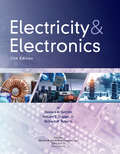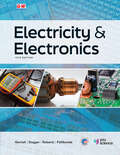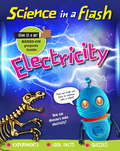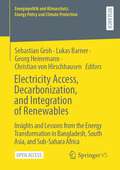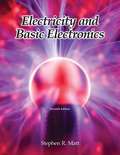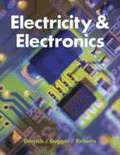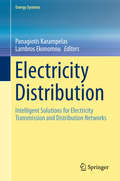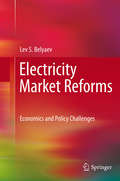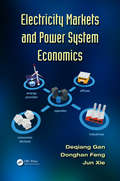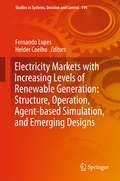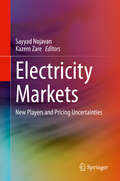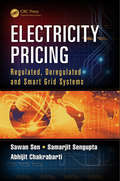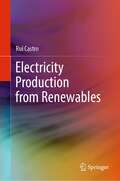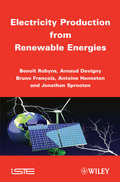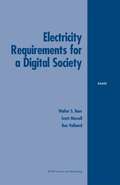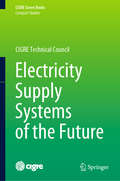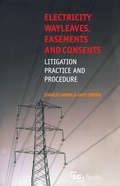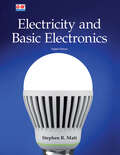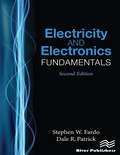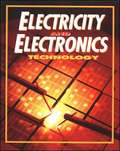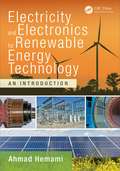- Table View
- List View
Electricity & Electronics
by Richard M. Roberts Howard H. Gerrish William E. Dugger Mahesh K. PallikondaElectricity & Electronics provides comprehensive coverage of basic concepts and applications in the study of electronics and electrical technology. As students learn the foundational concepts, they also begin developing the skills and knowledge needed to perform laboratory activities. The text correlates to the certifications offered by the Electronics Technicians Association (ETA). Topics include circuitry, motor, generators, power distribution systems, and advanced systems. A chapter covering careers and entrepreneurship make learning relevant to students exploring or preparing for this career.
Electricity (Merit Badge Series)
by Boy Scouts of AmericaThis book introduces scouts to the generation of and uses of electricity.
Electricity (Science in a Flash #23)
by Georgia Amson-BradshawunfortunatelyWhat's the buzz about electricity? All bright sparks need to read this book to discover the shocking facts about electricity, as well as all about batteries, circuits and conductors.This essential KS2 series for children aged 7 and up covers all the key science topics in energetic, quick-fire way, aiding clear comprehension by getting straight to the point! Each spread starts with a 'flash' or headline, summing-up succinctly the science information to follow. Attractive and light-hearted illustration visually conveys the information, adding depth and detail to engage children. Also includes fun jokes and cartoons to keep even the most reluctant readers entertained.
Electricity Access, Decarbonization, and Integration of Renewables: Insights and Lessons from the Energy Transformation in Bangladesh, South Asia, and Sub-Sahara Africa (Energiepolitik und Klimaschutz. Energy Policy and Climate Protection)
by Sebastian Groh Christian Von Hirschhausen Lukas Barner Georg HeinemannThis Open-Access-Book covers different aspects of the low-carbon energy transformation in a unique manner, with a particular focus on two regions, South Asia and Sub-Saharan Africa. The first part of the book provides useful insights on changes and reforms in the energy sector of Bangladesh, while the second part illustrates the low-carbon energy transformation in South Asia and the third part covers lessons from Sub-Saharan Africa. In all of these regions, the energy sector is undergoing major changes, driven by the four D’s: Decarbonization, decentralization, digitization, and democratization. Major overhauls are taking place at all levels: The country level, where energy mixes are rapidly changing, the corporate level, where large state-owned and private companies are challenged and new actors are emerging, and the local level, where technical and regulatory change has made citizen engagement and community power an option to replace or at least complement centralized supply structures.
Electricity And Basic Electronics
by Stephen R. MattElectricity and Basic Electronics teaches basic theory and fundamentals and is a starting point for careers in electronics. The text is clearly written and highly illustrated, making it easy for beginners to understand. Numerous examples walk students step-by-step through circuit analysis where applicable. The Practical Application and Project feature covers topics such as breadboarding, soldering, and reading voltage on an oscilloscope. There are 16 practical applications in all. The Project features, 28 in all, allow students to build items such as a continuity tester, blown fuse indicator, and power supply. Projects typically include a schematic, a picture of the finished product, and a procedure for assembling the project. A new Math Focus feature provides students with a quick review of the basic math skills they need to understand the topic at hand. Math topics covered are exponents, scientific notation, metric and electrical prefixes, order of operations, algebraic equations, adding fractions, rations and proportions, and square roots. A new chapter called “Energy Conservation” covers ways to conserve energy and alternative forms of energy. Geothermal systems, photovoltaics, and wind turbines are just some of the topics covered.
Electricity And Electronics
by Richard M. Roberts Howard H. Gerrish William DuggerTextbook on the fundamentals for technical school students. No bibliography.
Electricity Distribution
by Panagiotis Karampelas Lambros EkonomouThisbook introduces readers to novel, efficient and user-friendly software toolsfor power systems studies, to issues related to distributed and dispersed powergeneration, and to the correlation between renewable power generation andelectricity demand. Discussing new methodologies for addressing grid stabilityand control problems, it also examines issues concerning the safety andprotection of transmission and distribution networks, energy storage and powerquality, and the application of embedded systems to these networks. Lastly, thebook sheds light on the implications of these new methodologies anddevelopments for the economics of the power industry. As such, it offersreaders a comprehensive overview of state-of-the-art research on modernelectricity transmission and distribution networks.
Electricity Market Reforms
by Lev S. BelyaevWith the global demand for energy skyrocketing, over the past twenty years many countries have restructured their electric power industries, typically moving from a regulated monopoly to a competitive market structure. The results of these reforms vary significantly from country to country depending on the market organization model and national conditions. This book examines the restructuring in both developed and developing nations, with particular focus on the United States, Great Britain, China, and Russia, and addresses the problems arising from these transitions. The book also contains a comprehensive analysis of different electricity market models and their compatibility with the properties of electric power systems and country conditions. As the most thorough and up to date analysis of the theory and practical experience of electricity deregulation, this book is a must-read for academics, students and researchers with an interest in electric power industry restructuring. It also has direct relevance for engineers, regulators and other decision makers in companies and governmental agencies concerned with energy issues.
Electricity Markets and Power System Economics
by Deqiang Gan Donghan Feng Jun XieAfter the first power plant in history was commissioned for commercial operation by Thomas Edison on Pearl Street in New York in 1882, electricity was sold as a consumer product at market prices. After a period of rapid development, electricity had become such a fundamental product that regulation was believed to be necessary. Since then, the power
Electricity Markets with Increasing Levels of Renewable Generation: Structure, Operation, Agent-based Simulation, and Emerging Designs
by Fernando Lopes Helder CoelhoThis book describes the common ground between electricity markets (EMs) and software agents (or artificial intelligence generally). It presents an up-to-date introduction to EMs and intelligent agents, and offers a comprehensive description of the research advances and key achievements related to existing and emerging market designs to reliably and efficiently manage the potential challenges of variable generation (VG). Most EMs are unique in their complex relationships between economics and the physics of energy, but were created without the notion that large penetrations of variable generation (VG) would be part of the supply mix. An advanced multi-agent approach simulates the behavior of power markets over time, particularly markets with large-scale penetrations of renewable resources. It is intended as a reference book for researchers, academics and industry practitioners, but given the scope of the chapters and the highly accessible style, the book also provides a coherent foundation for several different graduate courses.
Electricity Markets: New Players and Pricing Uncertainties
by Sayyad Nojavan Kazem ZareThis book analyzes new electricity pricing models that consider uncertainties in the power market due to the changing behavior of market players and the implementation of renewable distributed generation and responsive loads. In-depth chapters examine the different types of market players including the generation, transmission, and distribution companies, virtual power plants, demand response aggregators, and energy hubs and microgrids. Expert authors propose optimal operational models for short-term performance and scheduling and present readers with solutions for pricing challenges in uncertain environments. This book is useful for engineers, researchers and students involved in integrating demand response programs into smart grids and for electricity market operation and planning.Proposes optimal operation models;Discusses the various players in today's electricity markets;Describes the effects of demand response programs in smart grids.
Electricity Pricing: Engineering Principles and Methodologies (Power Engineering (Willis))
by Lawrence J. VogtAs the advent of the Smart Grid revolutionizes how homeowners and businesses purchase and manage power, electricity pricing is becoming more complicated and intricate than ever before, while the need for more frequent rate revisions remains a primary issue in the field. A timely and accessible guide for the new industry environment, Electricity Pricing: Engineering Principles and Methodologies helps those involved in both the engineering and financial operations of electric power systems to "get the money right" while ensuring reliable electric service at a fair and reasonable cost. Explores both the business functions and engineering principles associated with electricity pricing Examining pricing approaches and opportunities, this book presents tools, viewpoints, and explanations that are generally not found in contemporary literature. It clarifies valuable analysis techniques, realistic examples, and unique lessons passed along from those inside the industry. This "how to do it" guide fosters a multidisciplinary understanding that integrates information, methodologies, and techniques from accounting, economics, engineering, finance, and marketing. Detail-oriented but still mindful of the big picture, this book examines the complex relationship between electricity, customers, and service providers in relation to pricing. Electricity Pricing also: Presents mathematical methods and techniques used to establish electricity prices, determine cost causation, and evaluate pricing structures and mechanisms Explores ways to translate and integrate cost elements into practical pricing structures Details how engineering concepts are used to apportion production, delivery, and associated costs to determine cost of service and to support all aspects of ratemaking strategy, design, analysis, and decision making This comprehensive professional reference addresses theory but remains grounded in no-nonsense practical applications. It is dually suited to introduce newcomers to the technical principles and methodologies of electricity pricing and provide veterans with a valuable consolidation of advanced tools for pricing analysis and problem solving. Watch an interview of the author at http://youtu.be/4fU8nkDVhNY
Electricity Pricing: Regulated, Deregulated and Smart Grid Systems
by Samarjit Sengupta Abhijit Chakrabarti Sawan SenElectricity Pricing: Regulated, Deregulated and Smart Grid Systems presents proven methods for supplying uninterrupted, high-quality electrical power at a reasonable price to the consumer. Illustrating the evolution of the power market from a monopoly to an open access system, this essential text: Covers voltage stability analysis of longitudinal power supply systems using an artificial neural network (ANN) Explains how to improve performance using flexible alternating current transmission systems (FACTS) and high-voltage direct current (HVDC) Takes into account operating constraints as well as generation cost, line overload, and congestion for expected and inadvertent loading stress Goes beyond FACTS and HVDC to provide multi-objective optimization algorithms for the deregulated power market Proposes the use of stochastic optimization techniques in the smart grid, preparing the reader for future development Electricity Pricing: Regulated, Deregulated and Smart Grid Systems offers practical solutions for improving stability, reliability, and efficiency in real-time systems while optimizing electricity cost.
Electricity Production from Renewables
by Rui CastroThis textbook is about economically competitive renewable energy sources (RES), including onshore and offshore wind, solar and small-hydro plants, and focusing on the electricity production from these sources. Clearly divided into sections discussing the different RES, the textbook begins with an introduction of AC electrical circuits, aimed at non-electrical engineers. It then offers an economic assessment of renewable energy projects, before discussing photovoltaic technologies and concentrated solar power. It explores the theory of wind to power conversion, electrical generator types and electrical part of offshore systems. Presenting theoretical concepts related to the electrical framework associated with RES, alongside examples and solved problems, this book will clearly introduce the topic of renewable power sources to graduate students, researchers and practitioners alike. After reading the book, readers will be equipped to make a preliminary techno-economic assessment of a RES.
Electricity Production from Renewables Energies
by Benoît Robyns Jonathan Sprooten Arnaud Davigny Antoine Henneton Bruno FrançoisEnergy and environmental issues have caused a marked increase in electricity production from renewable energy sources since the beginning of the 21st Century. The concept of sustainable development and concern for future generations challenge us every day to produce new technologies for energy production, and new patterns of use for these energies. Their rapid emergence can make the understanding and therefore the perception of these new technologies difficult. This book aims to contribute to a better understanding of the new electricity generation technologies by addressing a diverse audience. It presents the issues, sources and means of conversion into electricity using a general approach and develops scientific concepts to understand their main technical characteristics.Systems of electricity generation from renewable energy resources of small to medium powers are presented. The basic electrical concepts necessary for understanding the operating characteristics of these energy converters are introduced, and the constraints and problems of integration in the electrical networks of those means of production are discussed. Several exercises are provided to the reader for evaluation purposes.Contents1. Decentralized Electricity Production from Renewable Energy, Benoît Robyns.2. Solar Photovoltaic Power, Arnaud Davigny.3. Wind Power, Bruno Francois and Benoît Robyns.4. Terrestrial and Marine Hydroelectricity: Waves and Tides, Benoît Robyns and Antoine Henneton.5. Thermal Power Generation, Jonathan Sprooten.6. Integration of the Decentralized Production into the Electrical Network, Benoît Robyns.
Electricity Requirements for a Digital Society
by Scott Hassell Ben A. Vollaard Walter S. BaerGreater use of information and communications technologies (ICTs) marks a U.S. transition toward a "digital society" that may profoundly affect electricity supply, demand, and delivery. RAND developed four 2001-2021 scenarios of ICT evolution and assessed their implications for U.S. electricity requirements. Even large deployment of ICTs will only modestly increase U.S. electricity use over the next two decades. The more pressing concern will be how to meet the increased need for higher-quality and more-reliable power that accompanies ICT use.
Electricity Supply Systems of the Future (CIGRE Green Books)
by Nikos Hatziargyriou Iony Patriota de SiqueiraThis book offers a vision of the future of electricity supply systems and CIGRE’s views on the know-how that will be needed to manage the transition toward them. A variety of factors are driving a transition of electricity supply systems to new supply models, in particular the increasing use of renewable sources, environmental factors and developments in ICT technologies. These factors suggest that there are two possible models for power network development, and that those models are not necessarily exclusive: 1. An increasing importance of large networks for bulk transmission capable of interconnecting load regions and large centralized renewable generation resources, including offshore and of providing more interconnections between the various countries and energy markets. 2. An emergence of clusters of small, largely self-contained distribution networks, which include decentralized local generation, energy storage and active customer participation, intelligently managed so that they operate as active networks providing local active and reactive support. The electricity supply systems of the future will likely include a combination of the above two models, since additional bulk connections and active distribution networks are needed in order to reach ambitious environmental, economic and security-reliability targets. This concise yet comprehensive reference resource on technological developments for future electrical systems has been written and reviewed by experts and the Chairs of the sixteen Study Committees that form the Technical Council of CIGRE.
Electricity Wayleaves, Easements and Consents
by Gary O'Brien Charles Hamer'Wayleave' is an archaic term from the nineteenth century defined as 'a privilege enabling a person to cross another person’s land with infrastructure and with goods and chattels'. It has been applied to electricity rights because of the need to string electricity lines across land. Electricity is such a fundamental part of life that its supply is often taken for granted. In reality, the rights for electricity lines are arguably the weakest of all utilities, with the vast majority covered by wayleaves. Privatisation in the 1990s provided the opportunity to bolster wayleave rights, but it only led to a tinkering through primary legislation. The acceleration of telecommunications over the past twenty years has confused issues, with operators installing masts and adding apparatus to electricity lines. A large proportion of wayleaves are dealt with at local level, with little consistency. Coupled to this is the public concern that electricity lines have potentially serious health effects that continue to attract research and media interest. This book has been written for those involved in, or advising on, the use and development of land for transmission and distribution lines. As most people have only brief encounters with the electricity infrastructure, this guide will help to avoid the fear of the unknown. By setting out the main principles and procedures used and the relevant primary and secondary legislation in a clear and easy-to-follow way it will enable lawyers, surveyors, planners, architects, engineers and accountants to discuss the relevant issues with confidence.
Electricity and Basic Electronics
by Stephen R. MattElectricity and Basic Electronics is designed to reflect the ever-expanding interest in electricity and electronics. This popular introductory text teaches basic theory and fundamentals, and is a starting point for careers in electronics. The text is clearly written and highly illustrated, making it easy for beginning students to understand. Activities and projects provide real-world applications in home and industry.
Electricity and Basic Electronics
by Stephen R. MattElectricity and Basic Electronics teaches basic theory and fundamentals and is a starting point for careers in electronics. The text is clearly written and highly illustrated, making it easy for beginners to understand. Numerous examples walk students step-by-step through circuit analysis where applicable. <p><p>The Practical Application features cover topics such as breadboarding, soldering, and reading voltage on an oscilloscope. The Project features allow students to build items such as a continuity tester, blown fuse indicator, and power supply. Math Focus features provide students with a quick review of the basic math skills they need to understand the topic at hand. Math topics covered are exponents, scientific notation, metric and electrical prefixes, order of operations, algebraic equations, adding fractions, ratios and proportions, and square roots. A chapter called “Energy Conservation” covers ways to conserve energy and alternative forms of energy.
Electricity and Electronics Fundamentals, Second Edition
by Stephen W. Fardo Dale R. PatrickAn introductory text, Electricity and Electronics Fundamentals, delineates key concepts in electricity using a simplified approach that enhances learning. Mathematical calculations are kept to the very minimum and concepts are demonstrated through application examples and illustrations. The books span of topics includes vital information on direct current electronics, alternating current electricity and semiconductor devices as well as electronic circuits, digital electronics, computers and microprocessors, electronic communications, and electronic power control. Supplementary appendices provide a glossary and section on electrical safety along with an explanation of soldering techniques.
Electricity and Electronics Technology (Seventh Edition)
by McGraw-Hill Book Company Staff Marshall L. Schmitt Charles G. Carter Peter BubanHands-on practice and theory in one introductory text!
Electricity and Electronics for Renewable Energy Technology: An Introduction (Power Electronics and Applications Series)
by Ahmad Hemami<p>Electricity and Electronics for Renewable Energy Technology: An Introduction provides a foundational understanding of electricity and the methods and devices specific to electricity from renewable sources. The book begins with a brief explanation of the necessary mathematics and then: <p> <li>Addresses the basics of electricity and relationships, motors and generators, transformers, and networks and distribution <li>Tackles the key concepts associated with electronics, diodes and transistors, switching devices, and power converters <li>Covers digital electronics from number systems and logic circuits to encoders and decoders <li>Explores advanced subjects such as reactive power and the operation of a transistor</li> <p> <p>A lab manual and PowerPoint presentation are available with qualifying course adoption. <p>Featuring extensive review questions and practice problems at the end of each chapter, Electricity and Electronics for Renewable Energy Technology: An Introduction instills an essential knowledge of electricity and electronics required for work with renewable energy.</p>
Electricity and Electronics for Renewable Energy Technology: An Introduction (Power Electronics and Applications Series)
by Ahmad HemamiElectricity and Electronics for Renewable Energy Technology: An Introduction provides a foundational understanding of electricity and the methods and devices specific to electricity from renewable sources. The book begins with a brief explanation of the necessary mathematics and then: Addresses the basics of electricity and relationships, motors and generators, transformers, and networks and distribution Tackles the key concepts associated with electronics, diodes and transistors, switching devices, and power converters Covers digital electronics from number systems and logic circuits to encoders and decoders Explores advanced subjects such as reactive power and the operation of a transistor A lab manual and PowerPoint presentation are available with qualifying course adoption. Featuring extensive review questions and practice problems at the end of each chapter, Electricity and Electronics for Renewable Energy Technology: An Introduction instills an essential knowledge of electricity and electronics required for work with renewable energy.
